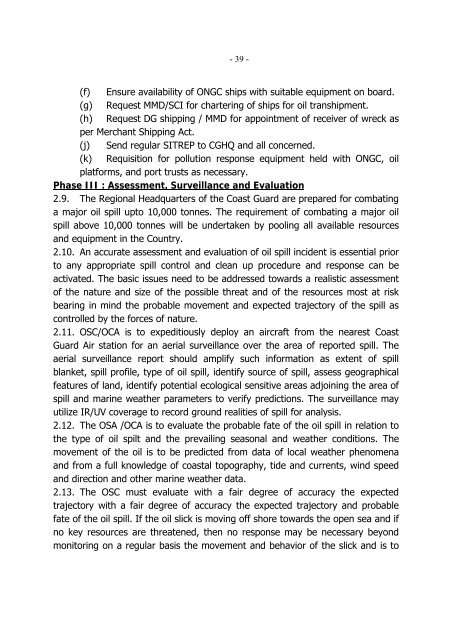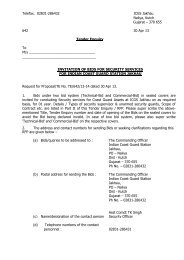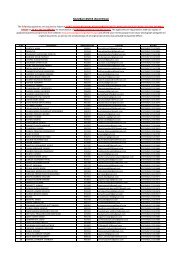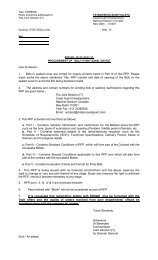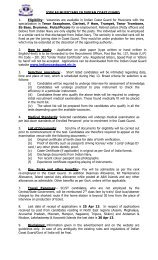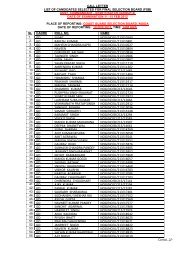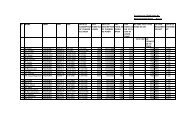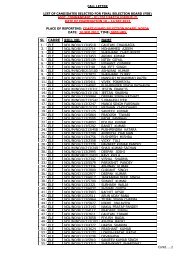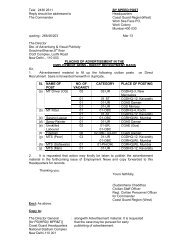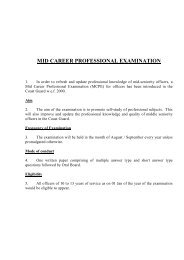eastern region oil spill disaster contingency plan - Indian Coast Guard
eastern region oil spill disaster contingency plan - Indian Coast Guard
eastern region oil spill disaster contingency plan - Indian Coast Guard
You also want an ePaper? Increase the reach of your titles
YUMPU automatically turns print PDFs into web optimized ePapers that Google loves.
- 39 -<br />
(f) Ensure availability of ONGC ships with suitable equipment on board.<br />
(g) Request MMD/SCI for chartering of ships for <strong>oil</strong> transhipment.<br />
(h) Request DG shipping / MMD for appointment of receiver of wreck as<br />
per Merchant Shipping Act.<br />
(j) Send regular SITREP to CGHQ and all concerned.<br />
(k) Requisition for pollution response equipment held with ONGC, <strong>oil</strong><br />
platforms, and port trusts as necessary.<br />
Phase III : Assessment, Surveillance and Evaluation<br />
2.9. The Regional Headquarters of the <strong>Coast</strong> <strong>Guard</strong> are prepared for combating<br />
a major <strong>oil</strong> <strong>spill</strong> upto 10,000 tonnes. The requirement of combating a major <strong>oil</strong><br />
<strong>spill</strong> above 10,000 tonnes will be undertaken by pooling all available resources<br />
and equipment in the Country.<br />
2.10. An accurate assessment and evaluation of <strong>oil</strong> <strong>spill</strong> incident is essential prior<br />
to any appropriate <strong>spill</strong> control and clean up procedure and response can be<br />
activated. The basic issues need to be addressed towards a realistic assessment<br />
of the nature and size of the possible threat and of the resources most at risk<br />
bearing in mind the probable movement and expected trajectory of the <strong>spill</strong> as<br />
controlled by the forces of nature.<br />
2.11. OSC/OCA is to expeditiously deploy an aircraft from the nearest <strong>Coast</strong><br />
<strong>Guard</strong> Air station for an aerial surveillance over the area of reported <strong>spill</strong>. The<br />
aerial surveillance report should amplify such information as extent of <strong>spill</strong><br />
blanket, <strong>spill</strong> profile, type of <strong>oil</strong> <strong>spill</strong>, identify source of <strong>spill</strong>, assess geographical<br />
features of land, identify potential ecological sensitive areas adjoining the area of<br />
<strong>spill</strong> and marine weather parameters to verify predictions. The surveillance may<br />
utilize IR/UV coverage to record ground realities of <strong>spill</strong> for analysis.<br />
2.12. The OSA /OCA is to evaluate the probable fate of the <strong>oil</strong> <strong>spill</strong> in relation to<br />
the type of <strong>oil</strong> spilt and the prevailing seasonal and weather conditions. The<br />
movement of the <strong>oil</strong> is to be predicted from data of local weather phenomena<br />
and from a full knowledge of coastal topography, tide and currents, wind speed<br />
and direction and other marine weather data.<br />
2.13. The OSC must evaluate with a fair degree of accuracy the expected<br />
trajectory with a fair degree of accuracy the expected trajectory and probable<br />
fate of the <strong>oil</strong> <strong>spill</strong>. If the <strong>oil</strong> slick is moving off shore towards the open sea and if<br />
no key resources are threatened, then no response may be necessary beyond<br />
monitoring on a regular basis the movement and behavior of the slick and is to


